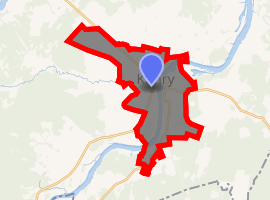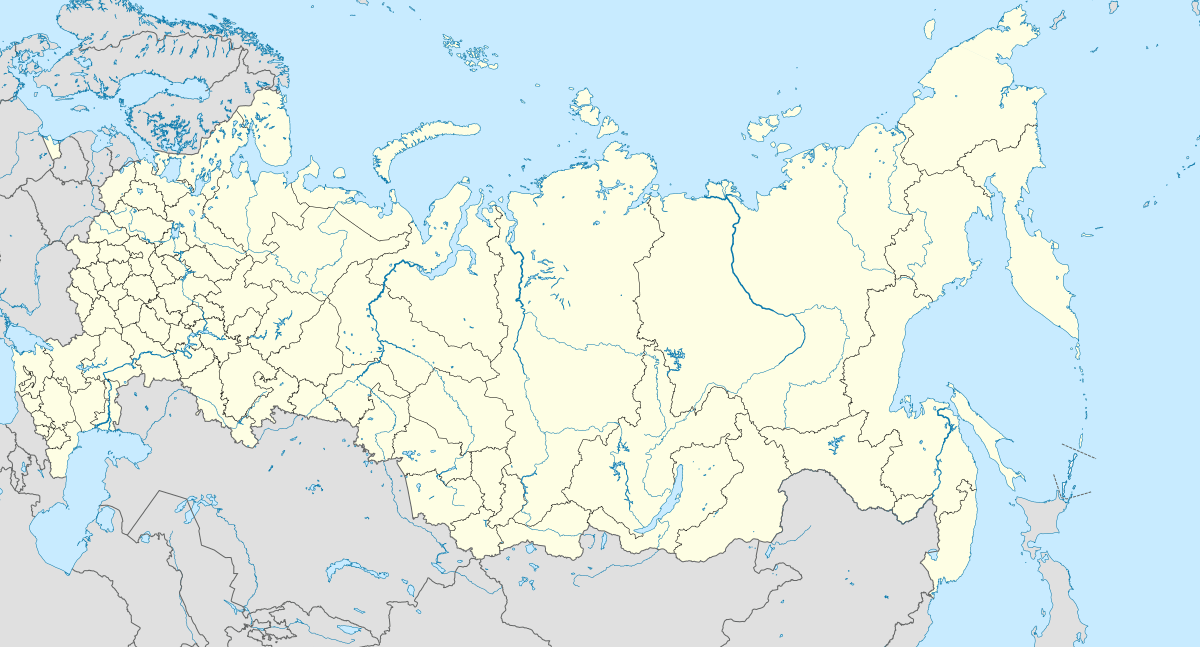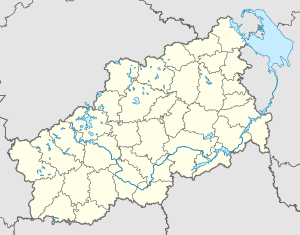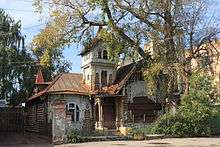Kimry
Kimry (Russian: Ки́мры), formerly Kimra (Кимра), is a town in the south of Tver Oblast, Russia, located on the Volga River at its confluence with the Kimrka River, 133 kilometers (83 mi) to the east of Tver. Population: 49,628 (2010 Census);[3] 53,650 (2002 Census);[9] 61,535 (1989 Census).[10]
Kimry Кимры | |
|---|---|
Town of oblast significance[1] | |
 Clockwise from top: Cathedral of the Transfiguration, Church of the Ascension, Kimry drama and comedy theatre, Kimry Bridge over Volga, Peasant house(?), Luzhin wooden house | |
.png) Flag  Coat of arms | |
Location of Kimry 
| |
 Kimry Location of Kimry  Kimry Kimry (Tver Oblast) | |
| Coordinates: 56°52′N 37°21′E | |
| Country | Russia |
| Federal subject | Tver Oblast[1] |
| First mentioned | 1546[2] |
| Town status since | 1917[2] |
| Elevation | 219 m (719 ft) |
| Population | |
| • Total | 49,628 |
| • Estimate (2018)[4] | 44,743 (-9.8%) |
| • Rank | 322nd in 2010 |
| • Subordinated to | Kimry Okrug[1] |
| • Capital of | Kimrsky District[5], Kimry Okrug[1] |
| • Urban okrug | Kimry Urban Okrug[6] |
| • Capital of | Kimry Urban Okrug[6], Kimrsky Municipal District[6] |
| Time zone | UTC+3 (MSK |
| Postal code(s)[8] | 171500–171508 |
| OKTMO ID | 28726000001 |
| Website | adm-kimry |
History

The town was known as Kimra until the beginning of the 20th century; the name is probably of Finnic or Baltic origin.[11] It was first mentioned in 1546[2] as a selo belonging to Ivan the Terrible. It belonged to Russian Tsars until 1677 and then was given to the Saltykov family.[2] In 1847, the inhabitants bought themselves out,[2] and Kimra quickly developed into a busy shoemaking and trading village on the left bank of the Volga (a boot appears on the town's coat of arms). Théophile Gautier wrote in his Voyage en Russie (1867): "Kimra est célèbre pour ses bottes comme Ronda pour ses guêtres" (Kimra is famous for its shoes as Ronda for its gaiters).[12] The district on the right bank of the Volga, known as Savyolovo, started to develop in 1901, when a railway connected the place to Moscow. Kimry was granted town status in 1917.[2] A number of old churches and other buildings still exist in the town.
In the 18th century, Kimra was included into Moscow Governorate. In 1775 it was transferred to newly established Tver Viceroyalty. In 1796, the Viceroyalty was abolished and transformed into Tver Governorate.[13] On December 30, 1918 Kimrsky Uyezd with the center in Kimry was established.[14] On 12 August 1929, Tver Governorate was abolished, and the area was transferred to Moscow Oblast.[14] Uyezds were abolished as well, and Kimrsky District, with the administrative center in Kimry, was established within Kimry Okrug of Moscow Oblast. On July 23, 1930, the okrugs were abolished, and the districts were directly subordinated to the oblast. On January 29, 1935 Kalinin Oblast was established, and Kimrsky District was transferred to Kalinin Oblast. In 1990, Kalinin Oblast was renamed Tver Oblast.
Administrative and municipal status
Within the framework of administrative divisions, Kimry serves as the administrative center of Kimrsky District,[5] even though it is not a part of it.[1] As an administrative division, it is incorporated separately as Kimry Okrug—an administrative unit with the status equal to that of the districts.[1] As a municipal division, Kimry Okrug is incorporated as Kimry Urban Okrug.[6]
Economy
Industry
Kimry is an industrial town, with several enterprises of manufacturing industry (machines and equipment for manufacturing industry), timber industry (furniture), as well as production of shoes, clothing, and food.[15]
- Savyolovo Engineering Plant SMZ (Mashinostroitelny Zavod)
Transportation
The town is served by the Kimry Airport. There are no passenger flights.
A railway connecting Moscow with Kashin and further with Sonkovo and Saint-Petersburg passes Kimry. There is a regular suburban passenger traffic between Moscow and Savyolovo, and a regular infrequent traffic between Savyolovo and Kashin. Savyolovo railway station is the northern terminus of the Savyolovsky suburban railway line.
Paved roads connect Kimry with Tver, Taldom, Kashin, and Kalyazin.
The Volga is navigable, but there is no passenger navigation.
Culture and recreation

Kimry contains one cultural heritage monuments of federal significance and additionally eighty-three objects classified as cultural and historical heritage of local significance. The federal monument is the Ascension Church, built in 1813. Kimry preserved many of the pre-1917 buildings, many of which are protected.[16]
There is a local museum in Kimry. It has expositions on local history, shoe industry, as well as has a memorial room of the aircraft designer Andrei Tupolev, born in a village near Kimry.[17]
Notable people
Kimry is the birthplace of aircraft designer Andrei Tupolev (1888), writer Alexander Fadeyev (1901), and orientalist Pavel Gusterin (1972).
International relationships
References
Notes
- Law #34-ZO
- Энциклопедия Города России. Moscow: Большая Российская Энциклопедия. 2003. p. 188. ISBN 5-7107-7399-9.
- Russian Federal State Statistics Service (2011). "Всероссийская перепись населения 2010 года. Том 1" [2010 All-Russian Population Census, vol. 1]. Всероссийская перепись населения 2010 года [2010 All-Russia Population Census] (in Russian). Federal State Statistics Service.
- "26. Численность постоянного населения Российской Федерации по муниципальным образованиям на 1 января 2018 года". Federal State Statistics Service. Retrieved January 23, 2019.
- Государственный комитет Российской Федерации по статистике. Комитет Российской Федерации по стандартизации, метрологии и сертификации. №ОК 019-95 1 января 1997 г. «Общероссийский классификатор объектов административно-территориального деления. Код 28 228», в ред. изменения №278/2015 от 1 января 2016 г.. (State Statistics Committee of the Russian Federation. Committee of the Russian Federation on Standardization, Metrology, and Certification. #OK 019-95 January 1, 1997 Russian Classification of Objects of Administrative Division (OKATO). Code 28 228, as amended by the Amendment #278/2015 of January 1, 2016. ).
- Law #4-ZO
- "Об исчислении времени". Официальный интернет-портал правовой информации (in Russian). June 3, 2011. Retrieved January 19, 2019.
- Почта России. Информационно-вычислительный центр ОАСУ РПО. (Russian Post). Поиск объектов почтовой связи (Postal Objects Search) (in Russian)
- Russian Federal State Statistics Service (May 21, 2004). "Численность населения России, субъектов Российской Федерации в составе федеральных округов, районов, городских поселений, сельских населённых пунктов – районных центров и сельских населённых пунктов с населением 3 тысячи и более человек" [Population of Russia, Its Federal Districts, Federal Subjects, Districts, Urban Localities, Rural Localities—Administrative Centers, and Rural Localities with Population of Over 3,000] (XLS). Всероссийская перепись населения 2002 года [All-Russia Population Census of 2002] (in Russian).
- "Всесоюзная перепись населения 1989 г. Численность наличного населения союзных и автономных республик, автономных областей и округов, краёв, областей, районов, городских поселений и сёл-райцентров" [All Union Population Census of 1989: Present Population of Union and Autonomous Republics, Autonomous Oblasts and Okrugs, Krais, Oblasts, Districts, Urban Settlements, and Villages Serving as District Administrative Centers]. Всесоюзная перепись населения 1989 года [All-Union Population Census of 1989] (in Russian). Институт демографии Национального исследовательского университета: Высшая школа экономики [Institute of Demography at the National Research University: Higher School of Economics]. 1989 – via Demoscope Weekly.
- Е. М. Поспелов. "Географические названия мира" (Москва, 1998), стр. 201.
- Théophile Gautier, Voyage en Russie (Charpentier, 1867), p. 233.
- Российская империя: административно-территориальное деление (1708–1917): Тверская губерния (in Russian). Russian National Library. Retrieved July 12, 2013.
- Справка об изменениях в административно-территориальном делении Тверской губернии - Калининской области (in Russian). Архивы России. Archived from the original on April 19, 2012. Retrieved July 11, 2013.
- Кимры:Предприятия промышленного комплекса (in Russian). Земля в Тверской области. Retrieved August 14, 2014.
- Памятники истории и культуры народов Российской Федерации (in Russian). Russian Ministry of Culture. Retrieved June 2, 2016.
- Кимрский краеведческий музей (in Russian). Российская сеть культурного наследия. Archived from the original on August 3, 2014. Retrieved August 14, 2014.
Sources
- Законодательное Собрание Тверской области. Закон №34-ЗО от 17 апреля 2006 г. «Об административно-территориальном устройстве Тверской области», в ред. Закона №66-ЗО от 1 октября 2014 г. «О внесении изменения в статью 18 Закона Тверской области "Об административно-территориальном устройстве Тверской области"». Вступил в силу со дня официального опубликования. Опубликован: "Тверские ведомости", №17 (специальный выпуск), 19 апреля 2006 г. (Legislative Assembly of Tver Oblast. Law #34-ZO of April 17, 2006 On the Administrative-Territorial Structure of Tver Oblast, as amended by the Law #66-ZO of October 1, 2014 On Amending Article 18 of the Law of Tver Oblast "On the Administrative-Territorial Structure of Tver Oblast". Effective as of the official publication date.).
- Законодательное Собрание Тверской области. Закон №4-ЗО от 18 января 2005 г. «Об установлении границ муниципальных образований Тверской области и наделении их статусом городских округов, муниципальных районов», в ред. Закона №65-ЗО от 24 июля 2012 г. «О внесении изменения в статью 2 Закона Тверской области "Об установлении границ муниципальных образований Тверской области и наделении их статусом городских округов, муниципальных районов"». Вступил в силу через десять дней после официального опубликования. Опубликован: "Тверские ведомости", №3, 21–27 января 2005 г. (Legislative Assembly of Tver Oblast. Law #4-ZO of January 18, 2005 On Establishing the Borders of the Municipal Formations of Tver Oblast and on Granting Them the Status of Urban Okrugs, Municipal Districts, as amended by the Law #65-ZO of July 24, 2012 On Amending Article 2 of the Law of Tver Oblast "On Establishing the Borders of the Municipal Formations of Tver Oblast and on Granting Them the Status of Urban Okrugs, Municipal Districts". Effective as of the day which is ten days after the official publication.).